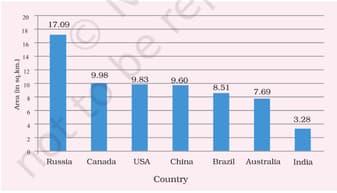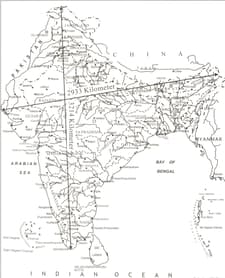The Arabian Sea is a vast body of water situated in the northwestern part of the Indian Ocean. It is surrounded by several countries, including India, Pakistan, Oman, Yemen, Somalia, and various other nations on the Arabian Peninsula. The Arabian Sea is an integral part of the maritime geography of South Asia and the Middle East, and it plays a crucial role in trade, transportation, and natural resource exploration in the region.
Which groups of Indian states have coastal access to the Arabian Sea?
Which groups of Indian states have coastal access to the Arabian Sea?
Gujarat, Daman and Diu, Maharashtra, and Goa
Karnataka, Uttar Pradesh, Kerala and Tamil Nadu
Madhya Pradesh, Uttar Pradesh, Mizoram and Tamil Nadu
Mizoram, Kerala, Nagaland and Tamil Nadu

Important Questions on India-Size and Location

Analysing the provided graphical representation, which includes data on the geographical areas of the seven largest countries, which of the following statements accurately describes the relative sizes of these countries in terms of land area, taking into account factors like territorial extent, regional distribution, and their positioning amongst the largest nations in the world?
In the heart of New Delhi, young Priya was fascinated by the concept of time. Her grandfather, an old scholar, told her the story of how Indian Standard Time (IST) became related to Greenwich Mean Time (GMT). Long ago, before railways and telegraphs, each town in India had its own local time based on the position of the sun. This made communication and transportation confusing. The British colonial rulers recognized the need for a standard time, so they decided to use GMT as the reference point.
Explore the historical background of Indian Standard Time (IST) and its connection to Greenwich Mean Time (GMT), and elucidate the far-reaching significance of this synchronization for India, considering how it impacted the country's administration, trade, and communication, and its role in unifying a geographically diverse nation.

Analyse the given image and provide a detailed geographic description of India's boundaries at the four cardinal directions, elucidating the specific geographical features, neighboring countries, and their significance, considering factors such as international relations, climate, and topography, in shaping India's regional diversity
On a detailed map of India, accurately identify and mark the Indian states through an important latitude at N passes.
